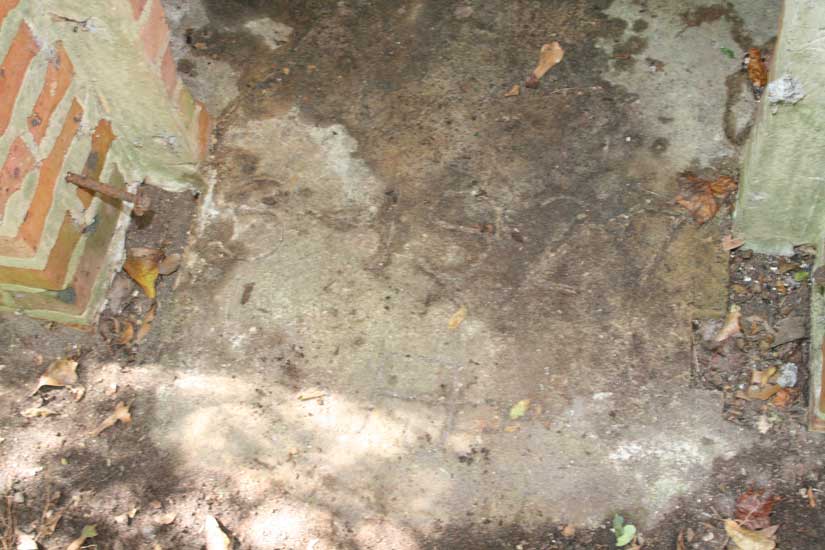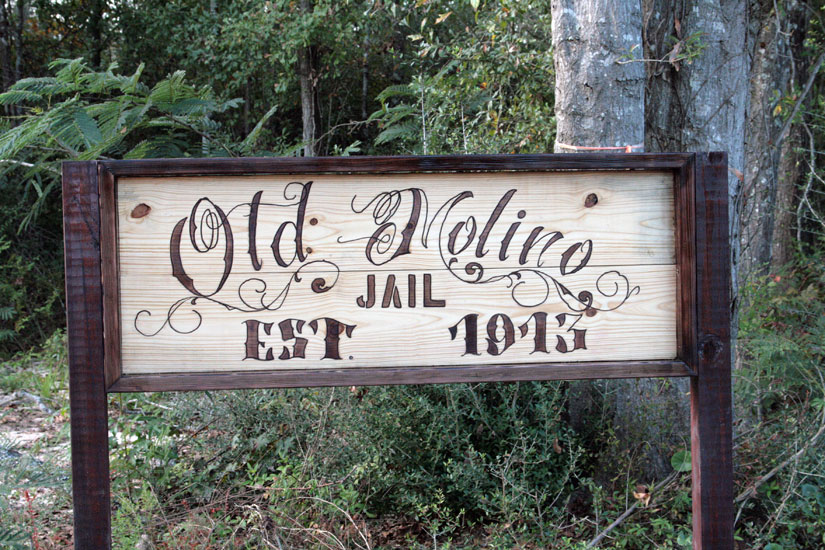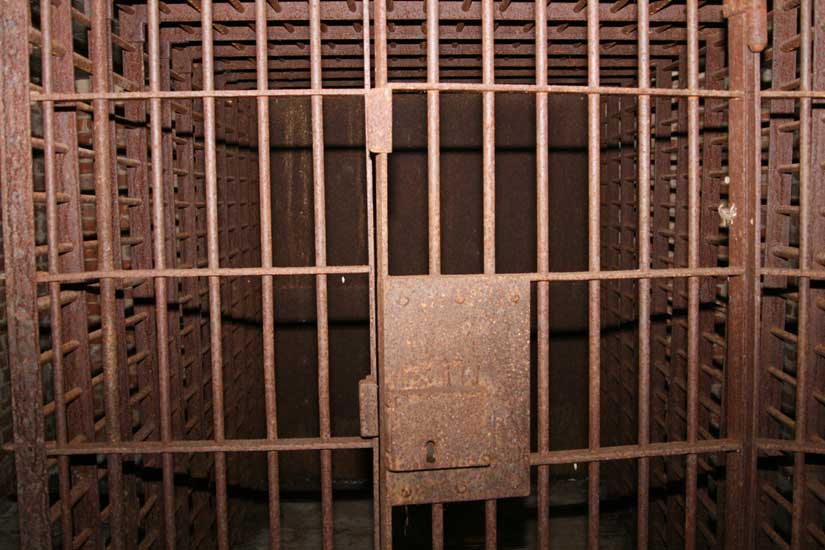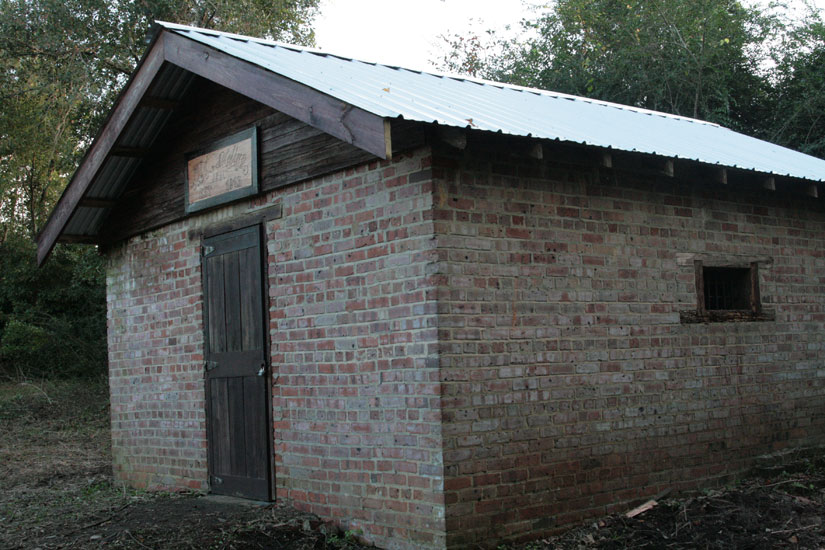Old Molino Jail: There’s A Lesson In There Somewhere (With Photo Galleries)
November 16, 2009
Molino was once a bustling little town complete with a mayor, a car dealership, a dentist, a bank, three doctors, a canning factory, a couple of mills, a railroad station — and criminals, mostly men with a little too much booze in them following a good payday.
The time was 1913, and Molino was incorporated as a town. A town hall and jail were constructed. But less than two dozen years later, a devastating fire and the Great Depression put an end to Molino’s roaring times. The town was dissolved in April, 1933, and the town hall and jail were given to Escambia County. Escambia County was charged by the Florida Legislature to maintain the fair grounds as a public park and the jail and city hall were to be maintained by the county “for use of peace officers of the said county”.
The town hall is long since gone; it was believed to have stood in front of the jail. But the jail still stands with one iron cell inside a small brick building. For years, it was hidden away yards from Brickyard Road, near Molino Road. Schoolchildren had an opportunity to visit the jail about 10 or 15 years ago. Since that time, it was almost forgotten behind thick brush.
For early 2008 photos from the inside and outside of the jail. click here.
Almost forgotten, but not by Lil King, Tom Helms and other members of the Molino Historical Society. King spent hours in Tallahassee looking for evidence that the jail belonged to Escambia County. It was a dollars and cents move. The historical society did not have the funds to restore the jail, but Escambia County would.
 King uncovered the document she was hoping to find, known as House Bill 322. The jail did in fact belong to Escambia County.
King uncovered the document she was hoping to find, known as House Bill 322. The jail did in fact belong to Escambia County.
The ownership revelation allowed the county to use county crews and prisoners from the Escambia County Road prison to clean the property. When NorthEscambia.com first visited the jail in February, 2008, reaching it was a trip down a little path through very thick brush. The kind of brush that only a machete and manpower would allow a human to pass. The trip was a near crawl. The photographer that was there from the city was nervously uncomfortable.
Over the course of that February day, road prison crews chomped away at the woods and the vines. clearing the lot for the first time in at least over a decade. The jail, once held prisoner by the growth of time, was once again free.
The small brick building was in remarkably good shape after all these years. The tongue and groove wood ceiling looked virtually undamaged. The roof needed some minor repair; and there was some water damage to wood around the bar-covered windows. The front door was missing.
There is just a single room in the old jail. It contains a single cell in the room, with a small area to walk around three sides of the cell. The door of old cell still swings freely, and does not even squeak. There is no obvious sign that the building was ever heated in winter and no bathroom. A February night in the Molino jail would bring cruel and unusual to mind.
 The faint outline of the 1927 date written in the concrete doorway (pictured left) at the time of the repair is still visible today. The jail was repaired after an explosion took off the door, possibly in an escape attempt, King said.
The faint outline of the 1927 date written in the concrete doorway (pictured left) at the time of the repair is still visible today. The jail was repaired after an explosion took off the door, possibly in an escape attempt, King said.
The road prison inmates dubbed the old jail as their “Camp One”, a play on words because the road department’s north end facility in Bratt is called Camp Five.
The inmate cleanup and restoration work at the jail were supervised by Jeff Bohannon, superintendent of the Escambia Road Prison. He said he was proud to be able to help clean up the lot for the historical society. And the prisoners on the work crew were equally proud to take part.
“You are contributing to a part of history,” Bohannon told the prisoners as they prepared for a lunch break during one cleanup effort. “I know you get out and do this kind of cleanup thing everyday, but this is special. When you get out, you can come back where with your kids or grandkids and show them what you helped do.”
 “I really appreciate each one of you. What you did today, and what you do everyday,” he said.
“I really appreciate each one of you. What you did today, and what you do everyday,” he said.
Several prisoners responded with a “thank you, sir”.
Inmates started their restoration with the front door — after all, a jail just isn’t a jail without a door. “It was built by the prisoners,” King said in March of 2008. “They are quite accomplished young men and some are already experienced carpenters and masons. I was happy to see the brick over the door put in; it gives a ‘finished’ look.”
For inmate Troy Cutts, 37, the Molino jail project has been a release from the road prison. Cutts was a carpenter before landing himself in the road prison. Part of his work on the jail included staining the new wood to look old. When gets out of jail, he wants to show his daughter the work he did on the old Molino jail.
There’s a good life lesson in there somewhere.
For early 2008 photos from the inside and outside of the jail. click here.
For photos of the jail restoration (courtesy Tom Helms) and a current day look at the jail, click here. Pitctured top: The single iron cell inside the 1913 Molino Jail. Pictured top inset: The faint outline of “1927″ in a repaired area of the door. Pictured bottom inset: The new sign at the old jail. Pictured below: The restored Molino Jail. NorthEscambia.com photos, click to enlarge.
Comments
14 Responses to “Old Molino Jail: There’s A Lesson In There Somewhere (With Photo Galleries)”





Was just down there yesterday evening and it’s getting so overgrown again. We can’t let our old history fade into oblivion like it once did!!!
My friend was the lead carpenter on the jail restoration. Troy Cutts is one of the best carpenters that I have ever known. His work on the jail, I,m, sure is done with as much professionalism and quality woodwork that would have been done by anyone anywhere. The replacement of the interior ceiling and and matching the new lumber to the 100 y.o existing wood is outstanding,you cant tell the new from the old. If I ever have to have specialized wood work done , I will definatally be locating Mr.CUTTS.
Thanks to everyone for all the time and effort for giving a little piece of history back to the world.
The Molino Mid-County Historical Society meets on the 2nd Thursday evening of each month at 6:30 P.M. (with the exception of no meeting in December). We meet at Aldersgate United Methodist Church on Highway 29 in Molino. The MMCHS does have a (small, free) website which is a work in progress: http://www.oldmolino.org.
Anyone and everyone is welcome to join our group.
Sharon, are you talking about the old “one room school house” on Fairground Rd, or the most recent old school house on 95-A? I know there are lots of photos out there because I’ve seen them from time to time. There is a calendar put out every year by the Historical Society with photos in it. But it is limited to just a few.
I was raised on Escambia River….My father is Gerorge (Red) Marlow & Richard Marlow is my uncle….my uncle & other family members still live at the public boat ramp. I know Fairground Road got it name because they use to have the fair their years ago. I would love to get more information on some of the history of molino. I am 44 yrs old so i had alot of years there myself. I would also like to know if anyone has any pictures & information of the old Molino School. I would also like to know if there is a a website for the Molino Historical Society,
Thanks William. I meant I would love to see more photos of all of “old Molino”. Sorry , I should’ve been more specific.
Hey the town hall was located beside the jail,the town hall was also a clinic and voting center,the building was a wooden structure,the canning factory is long gone along with the train depot,lumber mills and the molino river bridge, there was also three brick mills,but I think there was another jail also beside this one but its gone,but atleast this one was saved,its interesting in a way when you find out so much about old town history
Mr. Rodgers — The believed the town hall was located directly in front of old jail, but it is long since gone.
Does anyone know if there is a map where the town hall, canning factory etc.. is located? Is there any books that would have this information in it?
Deni — I am not aware of a website for them.
Other than a few pictures of the work itself, there is pretty much a picture of everything there in the photo galleries linked from the story above. The 2008 gallery above has all of the interior. It’s a very small place; there is no more to it.
Does anyone know if Molino Historical Society has a website? Would love to see more photos.
Very interesting. My family used to live in the old Parsonage down the road a bit. I used to pick blackberries around the jail as a child. I never knew it was a jail back then. That was 30 years ago.
I am very pleased to see the restoration of this old jail. I hope the interest will continue. It is a valuable part of our history. Thanks to everyone who had a hand in it. Good job! And thanks for the extremely good article…
I used to go to this even when it was over grown,and now that its cleaned up is even better,my dad is in the Molino Historical Society and this is good,thanks camp five for yalls help,there’s alot of old history around here buried in the woods